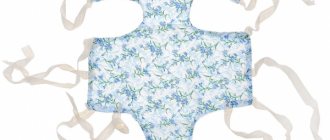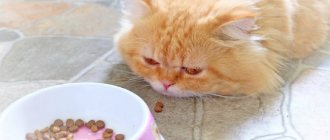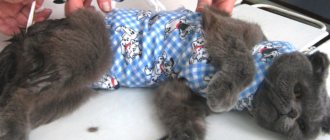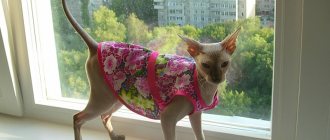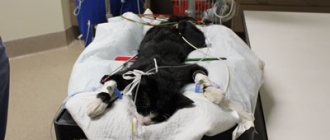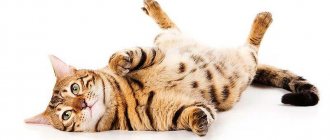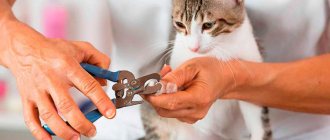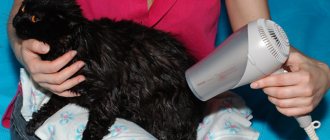Sterilization of cats is a abdominal operation to remove the reproductive organs of the animal. Most often, veterinarians make an incision along the linea alba. This area is easily accessible to the animal, so after the operation doctors strongly recommend putting a special blanket on the pet.
The blanket should be made of natural fabrics and be as comfortable as possible for the animal to wear for 7-10 days before removing the external seams.
It is advisable that the owner have several blankets, which will allow them to be changed and washed more often, keeping the wounds clean and protecting them from the penetration of pathogenic bacterial microflora.
In the absence of a blanket or a special bandage, the animal, after emerging from anesthesia, is able to lick the wound surface, even to the point of licking the suture material.
In addition, the animal can cause an infection or cause microtrauma with its rough tongue, which ultimately leads to inflammation of the suture.
Types of blankets and their purpose
Pet stores offer a large selection of blankets for cats. They differ from each other not only in size, but also in the material of manufacture, cut and purpose. So, protective clothing for cats is divided into:
- Warm blankets for protection from the cold. Mainly used for short-haired breeds of cats and sphinxes. Owners put sleeveless vests on their pets when taking them for a walk.
- Blankets for the home, in order to protect the owners from the shedding of the animal. This is especially true for people sensitive to various allergens. In addition, many owners do not want to constantly clean the apartment from a large amount of wool. Sphynxes also wear light cotton blankets to protect their furniture from stains. The fact is that hairless cats have an unpleasant feature - high sweating. Therefore, light clothing or a sleeveless T-shirt copes well with discharge and heavy shedding of fur. Some models of home blankets are also necessary for caring for seriously ill pets. In cats with tumors of the mammary glands, in order to avoid scratching the affected area, the owners put a blanket on their four-legged friend for constant wearing. For ease of wearing and removal, the ties on the blanket are replaced with a zipper.
- Rain blankets. This type of clothing is used when walking in cloudy and “dirty” weather. Made from nylon and vinyl chloride. Such protective equipment is used only on the street.
- Postoperative blankets. They became an excellent replacement for Elizabethan collars. Previously, cats were given collars after surgery. But this device is not entirely convenient. The pet cannot eat normally and move around the house with a collar, and as a result, recovery takes longer. Postoperative blankets have become the salvation of all domestic cats. After the operation, the animal feels good in protective clothing, recovers faster and can move freely around the apartment.
Using the fixture
The doctor puts a bandage on the cat immediately after sterilization, while the animal is under anesthesia. Before tying a protective blanket, press a sterile napkin soaked in an antiseptic to the wound. The blanket not only covers the damaged area of the skin, but also limits the animal’s movements. This is necessary so that the active scratch does not jump, otherwise the seams will come apart. The surgical incision is inspected and processed every other day, untying some of the tapes on the back and at the hind leg. If liquid appears on the surface of the fabric, the bandage is changed immediately.
After the surgeon removes the suture threads, the blanket is put back on the pet to protect the surface of the wound. But now the sanitary bandage is worn for 3–5 days. If the healing of the skin area is complete, the safety gown is finally removed.
How to fix it correctly
A blanket is laid out on the table and a cat is placed on top. If your mustachioed beast is impatient, ask another person to gently hold her. Talk kindly and calm the animal. Ribbons of the first pair (at the neck) are tied together above the withers, and numbers 2 and 3 are crossed above the beginning of the back and secured in one knot. The ribbons at the hind legs are connected on opposite sides: the sixth on the right and the seventh on the left. Tied together. The remaining two pairs of ribbons (4 and 5) are tied on the cat’s back. Veterinarians recommend making the ends of 7, 6 and 5 rows of ribbons in one knot to reduce the inconvenience of wearing a blanket for the animal.
The blanket should not be tied too tightly to prevent swelling of the pet’s skin.
The bandage should not be tight or too loose. It is considered optimal if a finger fits freely under the bandage. When an animal cannot walk in a blanket and falls, the fastening above the ridge is too rigid and should be loosened. Make sure that the cat does not accidentally damage the ribbons.
How long can you wear it without taking it off?
If the wound is dry, there is no swelling or redness, then after 8–10 days the bandage is removed. But at the same time, the cat cannot be left alone. Watch how she behaves. If he begins to intensively lick the wound or injure the sore area, then he will have to put on the blanket again and show the animal to the doctor. The cause of restless behavior is probably hidden inflammation.
Video: a cat walks around the house with a large bandage tied on its back
Features of using the bandage
For a cat, an oval cutout is made on the belly under the tail using a purchased or homemade blanket. Otherwise, you will have to untie some of the ribbons from the back and turn back the edge so that the animal can go to the toilet. This is inconvenient for both the owner and the sick pet.
Our mustachioed friends have different views on being forced to wear a blanket. Some show hatred with their entire appearance and persistently try to remove it by biting the ribbons with their teeth. Others are cunning and pretend that the protective bandage does not bother them at all. The reason for this behavior is simple - the cat is patiently waiting for the ribbons on its neck to loosen. And one morning you find your pet without a bandage, which was left lying somewhere in the corner of the room. It turns out that the cat has already pulled out all the threads from the wound. It is good if the suture is almost healed, i.e. there is no bleeding or fluid discharge. In some cases, you have to take your unruly pet to the surgeon again. Then the treatment is delayed for months, and a scar remains at the site of the incision.
How to choose the right blanket for a cat?
If your cat is undergoing surgery, you should choose a blanket before surgery. Your pet will quickly get used to the protective bandage and will feel much calmer in the postoperative period. Buy two sets at once so that you can replace the blanket if it gets dirty.
Pet stores offer several types of blankets, they differ in material and size.
The material used to make protective clothing is non-woven fabric. It is dense, and if you trim it, it does not crumble, it perfectly absorbs various secretions and liquid, thereby leaving the damaged area dry. Doesn't stretch after several washes.
When choosing a protective postoperative bandage for a cat, give preference to natural fabrics; they provide air flow to the affected area.
To choose the right size, you need to weigh your pet and measure the circumference of the sternum. A correctly chosen bandage leaves a small part of the back open (up to 9 cm). The volume is regulated by ties. Standard models of blankets for cats up to 5 kg start with a size of 38 cm (body length) and a chest circumference of 30 cm. For pets over 5 kg, bandages measuring 42x35 cm are suitable.
The blankets also have some differences in the method of fixation. They mainly sell bandages with ties that are fixed on the animal’s back. Less popular are models with Velcro instead of ties. Such models are suitable in cases of temporary wearing of blankets, for example, after sterilization or castration. Thick blankets with a zipper are considered the most comfortable. They are easy to take off and put on, they do not come unfastened and do not hinder the pet’s movement. But compared to regular ties, zippered jockstraps are a little more expensive.
Medical bandage for pet
To close a wound on the body of a domestic cat, ordinary bandaging is not enough. Feeling pain, the animal pulls off the bandage and chews out the surgical threads, risking infection in the suture. Therefore, veterinarians advise putting a sterile blanket on your pet. It is a blanket with holes for the paws and is tied at the back with ribbons. The device covers the lower part of the cat's body from the neck to the tail.
The main property of the product is to prevent pathogenic microflora from entering the surgical incision . Additionally protects the surface of the wound from sunlight and mechanical damage. When treating a sore spot with medications, the coverlet is partially untied without completely removing it.
Other uses:
- protection of the animal in the treatment of purulent ulcers and eczema;
- fixation of drainage;
- ensuring safety during treatment with acaricides;
- isolation of the tumor in the chest area;
- preventing contamination of animal care items.
The cost of a regular sanitary dressing is quite affordable. In November 2022, it was 75–120 rubles. This is a simple model with ribbons. If desired, the owner can purchase another version of factory tailoring with a pattern and fasteners with buttons, but in this case the price of the product will be from 1,700 rubles. a piece.
DIY blanket
If you want to sew a blanket for your pet yourself, you won’t have any difficulties. It’s easy to sew, and you can always find detailed diagrams and patterns on the Internet. It is best to select fabric for the bandage from your old things. The cat, feeling a familiar smell from the fabric, will feel much more confident and calm.
To make a postoperative bandage you will need:
- chintz or calico;
- ribbons;
- tools for work: pins, needles, threads, scissors, pencils and a ruler.
The dimensions of the pet are taken with a tailor's centimeter. Measurements needed to model the pattern:
- chest girth;
- length from withers to beginning of tail;
- peritoneal girth;
- the distance between the front and hind legs.
When cutting out parts, do not forget about an allowance of 0.5 cm. Before you start sewing, if you bought new fabric, be sure to wash it so that it shrinks.
Having cut out the parts, sew them together, machine the edges, and sew on fixing ropes. If desired, replace the rope with a zipper.
When preparing for surgery, prepare several blankets for each shift in advance to ensure your cat feels comfortable.
Features of sewing clothes for cats
One of the features of sewing clothes for cats is the choice of materials. Everything here is very individual, since this particular fabric and this particular style will suit each individual cat. And it’s not just about the breed, but also about the coloring of the pet’s coat, the size of the pet, and even the place it occupies in the owner’s heart.
Cat apron
In any case, special attention should be paid to natural materials. It is also possible to use fabrics with a small amount of synthetic fibers. The best option would be: cotton fabrics, linen, wool, viscose. They are pleasant not only for humans, but also for cats. You should also look at the characteristics of the material: how well it is made, whether it fades in the sun, or whether it deforms after washing.
Bow and dress
Also among the features is taking measurements of cats, which, naturally, differ from dogs, and even more so from humans. Taking measurements from animals is not so easy, since they constantly strive to break free.
McDonald's apron version
What types of postoperative sterile patches are there?
Surgery requires the subsequent application of a sterile medical post-operative plaster. It can replace a sterile dressing, providing the same functions - protecting a fresh wound from infection and subsequent problems. If the incision is small, it is possible to fix the edges of the wound. Manufacturers offer products with different impregnations, the effect of which is selected taking into account the need.
- Antibacterial patch for wound healing with silver. Accelerates skin regeneration. The absorbent base allows for repeated dressings much less frequently. There are products for children and adults, standard and waterproof.
- A postoperative non-woven bandage is made of elastic materials and is designed specifically for moving areas of the body. The microporous surface provides air exchange, which eliminates irritation and diaper rash. During dressing, the adhesive composition is easily separated from the skin, and no traces remain.
- Product for resolving sutures after surgery. Indications for use: epithelization of wounds and protection against re-infection. The material absorbs wound secretions well and protects the surface from mechanical and other impacts. Due to the transparent base, you can observe the process without peeling off the film each time.
Buy or sew?
You can buy a blanket at a specialized pet store. This is an option when a bandage is prescribed after a major operation, where maximum sterility and quality are required. The advantage of a purchased product: variety of colors, sizes, manufacturers.
The products are made from dense, lint-free non-woven materials. This way they don’t leave hairs and don’t form pellets after lying on the sofa. At the same time, they are easily adjusted and can be cut to fit the size of your pet.
The fabric fibers have a structure that quickly absorbs liquid. This is a big plus for the animal’s postoperative body when the wound is tightly covered with material and is not in danger of getting wet. Another advantage of a medical bandage is that it is not subject to rupture. They have a long service life, tolerate washing well and do not have harmful components that would have an aggressive effect on the pet’s skin.
However, if the owner is not ready to spend a lot of money, and the bandage was not a prerequisite for the doctor, you can make a blanket for the injured cat with your own hands.
How to take measurements from a cat
The main measurements to take are:
- neck girth. This is the circumference of the neck at its thickest and widest point. This is usually its base. To ensure an even measurement, it is necessary to place the animal on a flat surface;
- back length. The measurement is taken from the base of the neck to the beginning (root) of the ponytail. A centimeter placed along the spine is best suited for this;
- sternum girth. This measurement is taken around the widest part of the chest - under the front legs.
You might be interested in this: Patterns and sewing of blouses, tops and dresses with peplum
These measurements are enough for most products, but sometimes additional data is needed. For example, the distance between the paws.
Cat measurements
How much does a post-operative cat bandage cost, and how to tie it correctly?
Sequence of actions for tying a bandage:
- The blanket is carefully applied to the cat's stomach and chest when it is standing or lying on its side. The smaller part should be between the head and front paws, the larger part should be pressed to the abdomen.
- The first pair of ties are fixed on the neck.
- The left ribbon of the second pair is connected to the right third, the other two are tied in pairs so that a cross of ribbons is formed at the withers.
- The fourth and fifth pair are tied at the back.
- The remaining ribbons are wrapped around the animal’s hips (they run horizontally) and secured.
The blanket should fit snugly, but not squeeze the body, not restrict the movement of the paws, and not interfere with the cat's ability to go to the toilet.
The ribbons must be firmly fixed, otherwise the pet will be able to untie them and free itself from the bandage. Some cats are very resourceful and are able to get rid of even a well-fixed blanket, so the animal should be supervised for the first days after surgery.
Homemade
Among furry pets, there are also those who suffer from allergic shedding.
The owners have to constantly vacuum the furniture and often comb out the animals, although this does not save the situation. But you shouldn’t envy owners of “hairless” cats. Unfortunately, they have another physiological feature - increased sweating. There are stains on sofas and armchairs that are difficult to remove.
Therefore, pets are dressed in blankets made of light cotton fabric, reminiscent of a robe or T-shirt. Such clothing absorbs skin secretions well and limits hair loss.
A satin blanket will protect furniture from your pet's sweating.
Most home capes still belong to wardrobe items. However, some models are necessary for the daily care of animals with incurable diseases.
When veterinarians discovered a tumor on an elderly cat's mammary gland, the owners were forced to make difficult choices. They did not agree to the operation, which still would not bring recovery.
The pet constantly reached out to the sore spot and licked it. Redness and inflammation began. Then the owners put a loose blanket on the cat. It is surprising that the animal quickly got used to the “cover” and only slightly protested at first.
The tumor, covered with tissue, became less inflamed by the actions of the furry pet. The use of a protective device thus made it possible to extend the earthly existence of a doomed living creature for another year and a half.
Fastening a blanket with a zipper is much more convenient than tying ribbons.
When can I shoot?
When can you remove the blanket after sterilization? Here you should follow the recommendations of your veterinarian.
Important! It is usually recommended to remove it after 10-15 days; the wound usually does not heal faster.
Observation after removal of the bandage
After the bandage is removed, it is necessary to carefully monitor the cat's condition in the first days. The cat family is characterized by increased cleanliness, therefore, at first the animal will constantly lick the seam.
The owner must ensure that the cat does not chew the edges of the healed wound.
Be sure to read:
Complications after castration of a cat: causes, types, symptoms and treatment, when you need to see a doctor
Important points during inspection:
- monitor the integrity of the edges of the wound surface;
- control whether there is any discharge from the wound in the form of blood or lymph;
- inspect the seam for redness, inflammation, and the appearance of purulent discharge;
- check whether nodes or swellings have appeared along the edges of the wound surface.
Any of the identified anomalies is a reason for an unscheduled visit to the veterinarian.
Expert advice on proper wound treatment
Even the best dressing materials will not give the expected effect if used incorrectly. It’s not difficult to remember the recommendations of experts. All that remains is to remember them at the right time and promptly replenish your home first aid kit with everything necessary for first aid.
Before bandaging and dressing the wound, the damaged area itself and the skin around it must be treated taking into account a number of rules. Particular care is taken when treating wounds after surgery. The rules for using adhesive bandages are as follows:
- Before opening the package, wash your hands with soap, dry them with paper towels and treat them with an antiseptic;
- the next step is to make sure that the expiration date indicated on the package has not yet expired;
- When opening the packaging, you should avoid touching the product in those places that will come into contact with the wound;
- Having taken the dressing product out of the packaging, you should hold it only by the outer side;
- remove the polyethylene or paper strips covering the adhesive layer by holding the product by the free fragment;
- a strip is applied to a dry and clean wound so that its central impregnated section covers the entire wound, and the glue is located outside the damaged skin;
- unless otherwise provided, bandaging is done at least once a day. Exceptions are made for burns, when the bandage remains in place for a long time;
- To make a dressing, you need to grab the edge and hold the skin nearby with your free hand. Considering that you will need 2 hands at once, it is advisable that the person who is injured does not do the dressing.
Among the useful tips given by experts, there is often a recommendation to shave the skin around the wound. This is necessary because hair can cause infection of the wound surface even under a bandage and after treatment. In addition, the presence of even vellus hair makes dressing painful.
The recommendations listed in the article will help you pay due attention to the process of treating and dressing wounds. All that remains is to buy the necessary dressings, choosing medical products from trusted manufacturers. The range of products is quite wide, and prices vary depending on the brand and country of origin.
Instructions for putting on
Most often, the blanket is secured to the animal’s body using regular ties. Velcro versions are available for sale. Dressing a cat in such a bandage is much easier, but blankets with Velcro are more expensive.
The first putting on of the blanket occurs immediately after the operation. Most often at this time the animal is still under anesthesia or only partially conscious. In this state, the cat does not offer resistance, which greatly simplifies the process. You should be very careful and careful, do not make sudden movements when manipulating the animal’s body: fresh seams can be damaged very easily.
In the future, you will have to repeatedly treat the wounds and put a bandage on an already active animal. It is important to act as calmly as possible. If a cat is nervous and resists, talk kindly to your pet and pet it. Spread the bandage on the table and place the cat on top of it, tummy down.
It will be better if someone helps you the first time - it is much easier to carry out this process together.
Let one person calm and stroke the animal, and in the meantime you can carefully and slowly tie the laces of the bandage according to the pattern.
An original version of a blanket made from a sock
When the cat is small, instead of an expensive medical bandage, you can make a cat blanket from a sock or tights. All you need: a product of a suitable size (corresponds to the length of the body from the shoulder blades to the pelvis) and scissors. It is recommended to use a new sock as your pet's wounds need to be kept sterile.
Procedure:
- Cut the front of a sock, stocking or tights to create a fabric sleeve.
- If desired, you can make holes for the paws.
- Insert the pet into it, fixing the stomach.
- Make sure that the product does not put too much pressure on the wound, but does not sit too loosely on the body.
Blanket for a cat from scrap materials at home
If the cat is already large and small sock sizes are not suitable, you can sew a design from children's clothing, a T-shirt or pants.
This blanket does not have ties, it is cheap and does not take much time to make. An excellent option if you need a bandage for a short time.
Criterias of choice
In special stores for animals, you can easily choose and find out how to properly put on a blanket for a cat after sterilization. They all have their own differences in quality. In order for the postoperative period to be positive, it is necessary to choose the right bandage.
Initially, measure your animal, and then you will know what size it needs to be purchased. You can adjust them yourself using ties that are dimensionless in width.
Find out, first of all, what is the distance from the base of the neck to the tail. By choosing the right bandage, you will ensure comfort for your animal.
Many cat owners do not pay much attention to the color of the bandage, but in vain. On light-colored products, it will be much easier to see the presence of stains on the seam, and they can also give the first “alarm bells” that the bandage needs to be changed (in no case should dirt get into the wound).
Important! When selecting a bandage, you should pay special attention to the quality of the seams and ribbons. All seams must be made carefully and evenly, the threads must not stick out. After all, as soon as you put a blanket on your cat after sterilization, a thread may get into the wound, and this may cause suppuration.
If the seller in the store allows you to pick up the blanket, this may mean that many people have already touched it, and it will not be clean at all. It is better to give preference to the blanket that is packaged in transparent packaging. This way you will be confident in the quality of the product, and this is one of the important factors.
How to properly fix the edges of a wound?
Special adhesive-based healing dressings are used to fix the edges of wounds that are small and deep cuts. The purpose of the product is to prevent sloppy edges and the subsequent formation of an unsightly scar.
The most common area of application is plastic surgery, where it is necessary to tighten the wounds of damaged areas on the face. It is here that the facial muscles cause special mobility of the skin. If you do not fix the edges of the wound, scars will remain. Specialized products are more functional than regular dressings. Strip strips will ensure the formation of an even scar, which will subsequently resolve without leaving marks. At home, such strips are used for minor cuts. If the wound is deep, you should contact a specialist who will carry out proper treatment and then fix the wound for speedy healing.
